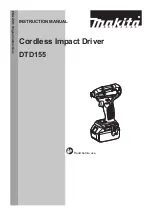
15
TIGHTENING AND REMOVING FASTENERS
The most common uses for the impact driver
are to drive or remove screws and to tighten or
loosen small nuts.
The principles for operating the impact driver
are the same for most applications. For
illustrative purposes, driving a wood screw is
shown.
PREPARING SCREW HOLES
It is important to prepare screw holes before
attempting to fasten two pieces of wood
together. Proper preparation will make screws
drive easier and prevent misaligned
components, stripped screw heads, splitting and
separating of wood components.
1.
Clamp the components that are to be
screwed together in their desired position
(Fig. 10).
2.
Drill a pilot hole (1) through the outer piece
(2) and into the inner piece (3). Drill the
hole 2/3 the diameter of the smooth portion
of the screw shank.
NOTE:
If the wood is soft, drill the hole 2/3 the
length of the screw. If the wood is hard, drill the
hole the full length of the screw.
3.
Remove the clamp from the two pieces to
be screwed together.
4.
Enlarge the hole (1) in the outer piece (2)
so it is the same size as the smooth portion
of the screw shank (Fig. 11).
5.
If using a flat head screw, counter-sink the
hole (4) so the head of the screw will be
flush with the surface when fully driven into
place.
DRIVING SCREWS
When driving screws, care must be taken to use
a bit that correctly fits the head of the screw
being driven. Be sure to use the largest bit size
that will properly fit into the head of the screw.
The bit must also be in good condition and not
worn so it will drive screws without slipping out
of the screw head.
Always hold the impact driver with two hands
when driving and removing screws to provide
the best possible control over the tool.
1.
Select the correct screwdriver bit for the
screw being driven.
2.
Insert the bit into the hex drive
(Fig. 6).
3.
Set the forward/reverse button to the LEFT
for driving screws (Fig. 7).
ASSEMBLY AND OPERATING
Fig. 10
Fig. 11
Содержание 147616
Страница 19: ...19 EXPLODED VIEW ...






































